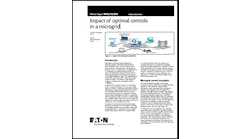While the devastation of Hurricane Harvey and the West’s wildfires are fresh in our minds, it’s critical to start focusing on grid resiliency — and how distributed energy can contribute to it.
Utilities and state regulators right now focus more on grid reliability than grid resiliency, said Kelly Speakes-Backman, CEO of the Energy Storage Association (ESA). But the two are very different.
“Reliability is about normal operations and the grid being able to run with scheduled down times of generation and scheduled operations and maintenance — to be able to count on it when you’ve scheduled it,” she said.
Resilience is all about being able to withstand or recover from the unplanned
Resilience, on the other hand, is all about being able to withstand or recover from the unplanned—the hurricanes, storms and wildfires we’re experiencing more often and with more intensity right now. “Everything that is non-planned has to do with resilience,” she said. Surprise disturbances also include cyber and other attacks on the grid, she said.
Resilience is needed during these “extraordinary and hazardous catastrophes utterly unlike the blue sky days during which utilities typically operate,” said a 2014 report by the National Association of Regulatory Utility Commissioners, “Resilience for Black Sky Days.” The report suggests that state regulators consider investments in resilience.
Distributed energy, energy storage and microgrids are especially important tools for building grid resiliency, said Speakes-Backman. For example, with natural-gas powered microgrids in place, more than a dozen Houston H-E-B stores were well prepared for Hurricane Harvey and also became critical resources for the community.
“They were ready to keep their own lights on, and provide emergency food, mobile kitchens, and other emergency services. They did this largely as part of their own corporate ethos of being engaged in the community,” said Matt Roberts, ESA vice president. “Microgrids not only provide a customer with resilience, but also can be leveraged to enable emergency response efforts.”
The day-to-day benefits of using storage to avoid outages include energy-bill savings, avoidance of food going bad, and the ability to integrate more energy into a local energy network, he said.
What power outages cost consumers
“We need to start thinking about investments to make the grid more sustainable and affordable for consumers,” added Speakes-Backman. “From a commercial and home standpoint, people lose medicine and food. There are lots of costs associated with being out for a long time. There are also health risks — people can’t get access to medical treatment.”
State regulators and utilities, however, are slow to recognize and place economic value on distributed energy resources as important grid resiliency tools, said Speakes-Backman. In fact, they focus more on grid reliability than resilience.
Part of the problem for the energy storage industry is regulators’ tendency to value energy storage for only one purpose, while it serves multiple benefits, she said. “There are questions about what kind of resource it is.” Storage both draws from the grid and gives back to the grid, sometimes providing efficiency, sometimes providing generation. It also relieves strain on the grid, and should receive compensation by utilities for all of this, she said.
“Because of those questions, there’s confusion about how to classify this type of system, and it’s not able to pull from all the revenue streams it creates value for.” Regulators don’t have the tools to put energy storage “in more than one bucket” for compensation, she said.
If the many benefits of energy storage were valued, planners could install microgrids and energy storage at critical points along the grid, providing resilience and warding off both the inconvenience and cost to the economy of outages, she added.
Incorporating grid resiliency in utility plans
One option for addressing grid resiliency and incorporating energy storage and microgrids could be including these resources in state integrated resource planning efforts, said Speakes-Backman. Under this process, state regulators generally look at generation or upgrading generation, but aren’t explicitly directed to investigate advanced energy storage and microgrids as investments.
“Because it’s not included in these plans, you need a utility willing to take the risk and go outside the bounds of a distribution integrated resource plan.” However, utilities aren’t big risk takers and can’t be counted on to do this. Instead, state legislators should enact legislation directing utility commissions to include energy storage in integrated resource planning, she said.
“In some cases, it’s legislation that directs the commission to consider it; a number of states have begun that process,” she said.
Legislators and regulators have a number of examples that point to the value of energy storage and microgrids providing grid resiliency.
For example, energy storage came to the rescue in 2015 when the Aliso Canyon gas leak was discovered, said Roberts.
“Following the discovery of the gas leak the California Public Utilities Commission and industry sprang into action and installed nearly 100 MW of energy storage to ensure reliability in the face of expected gas shortages. This was installed in record time (about six months) — an unheard of speed for providing just-in-time capacity where it was needed most,” he said.
Different answers, different states
But it isn’t always easy for regulators to decide how much to pay for the resiliency provided by these types of rescues, said Speakes-Backman.
“It’s a fascinating question for commissions to have to answer: How to deal with their specific regional types of increasing storms and how to justify investments in resilience,” she said. “Utility customers can only afford so much. Where do you spend that money? You’ll have different answers in different states.”
Read more articles about grid resiliency. Join our LinkedIn group, Distributed Energy Resources.






